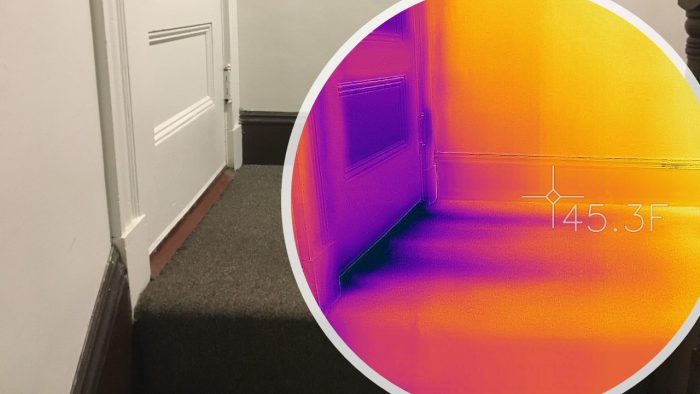
This article is the second in a series on various building diagnostic tools used to sleuth out problems in buildings. If you missed it, you may want to read Part 1: Air before diving in here.
I’m back to share more tools of the trade that I use for forensic examinations and to diagnose problems in buildings. The rough breakdown of these columns will cover the topics of air, heat, and moisture and the tools I use to identify how they are acting in a building. This time, we’re looking at heat, or more specifically temperature.
One of my go-to tools in building investigations is an infrared camera, or IR camera, which is the focus of this column. IR cameras are not always problem solvers, but they often pick up anomalies that offer useful clues, and they always provide entertaining stories. This article isn’t intended as an introduction to IR cameras. There are plenty of training classes you can find for that. It is intended instead to show how I use IR cameras to scan wide areas for cold spots, hot spots, and other “thermal anomalies,” as we call them in our reports.
Examples of Infrared Observations
To interpret infrared images, a color (or black and white) scale is used to represent surface temperatures. In the images below, I used a color scale where blue/purple show cooler temperatures, and yellow/orange show warmer temperatures. I should warn you that there have been plenty of times when my first glance at an infrared image resulted in the wrong answer. For instance, I walked into this house in rough frame, and was startled by the big warm thermal anomalies across the floor (Figure 1). Was heat running already, resulting in duct conduction through the floor? Nope, those are just the sunlit spots on the floor from the windows, and it wasn’t obvious at first because the sun had gone behind a cloud.
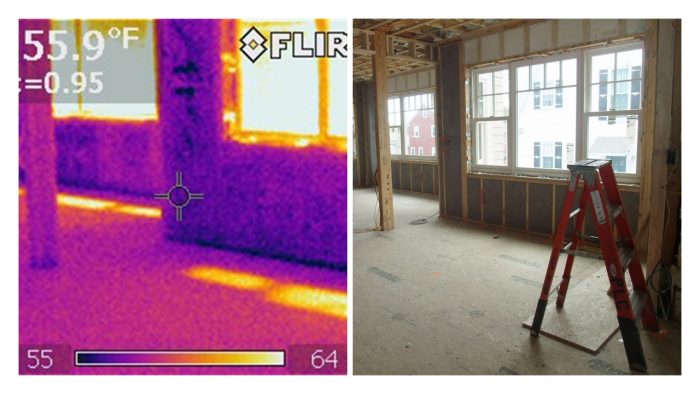
A really shocking example of air leakage is shown in Figure 2. Why are there bands of warm brick surfaces in this wintertime shot of a multifamily building? Thermal conduction through steel structure, perhaps?
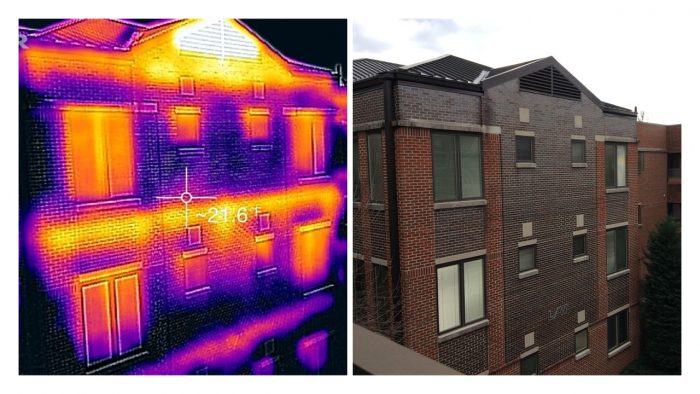
A look above the suspended ceiling showed a fireproofed steel perimeter beam above the concrete block/CMU and steel stud wall (Figure 3). If you look carefully, you can see a little bit of blue in the gap between the two. That’s blue Dow Styrofoam.
The problem is clearer in the building section (Figure 4). The building has a structural steel frame with infill CMU block and steel stud framing, that stops short of the steel. And there’s no exterior air barrier on this building, so outside air (from the brick cavity) is free to get through the foam joints and come in through this half-inch gap around the entire building’s perimeter.
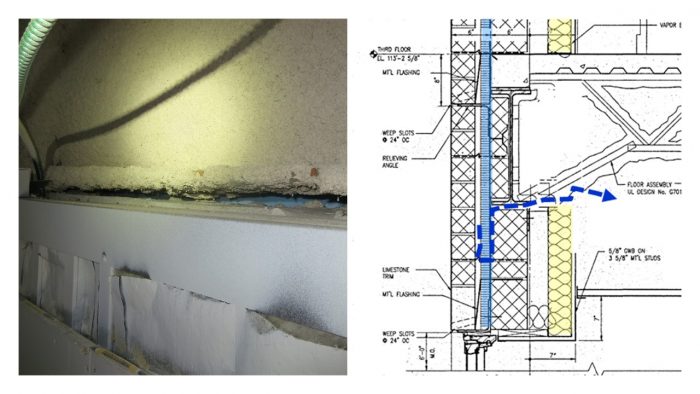
The warm air leaks shown in Figure 2 were worst towards the top of the building, consistent with stack effect, or warm air rising. But the problems were worse than just energy use. During the summer, stack effect reverses, and the lower levels tend to suck on the brick cavity. They were pulling in enough outside moist air that they were having condensation and mold problems on their chilled water piping, above the suspended ceiling.
Revealing water issues
An IR camera can also capture water issues; the key is capturing conditions at the right time. Rainfall often cools surfaces (especially in summer), and evaporation also cools wet surfaces. In addition, wet surfaces have greater thermal mass, so when the outdoor temperature is rising or falling, their response will lag behind the rest of the building.
This is shown at the windowsills of a masonry building in Figure 5. Windows or glass, unlike most wall claddings, shed almost all the wind-blown rain that hits them onto the wall below. As a result, windowsills are critical for draining this concentrated water away via drip edges, or else you end up with drool patterns below the windows, as shown.
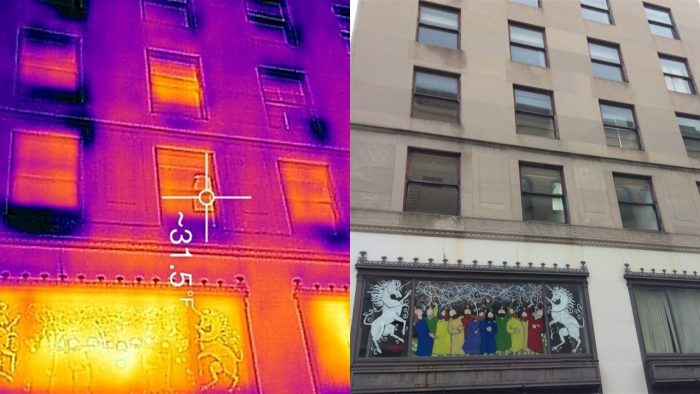
Thermal bridging through framing can be pretty obvious with an infrared camera if there’s an indoor-outdoor temperature difference. Figure 6 is a wintertime shot of steel studs, which are far more thermally conductive than wood studs. Thermal bridges such as uninsulated slab edges or structural steel embedded in insulated walls would show up in a similar way.
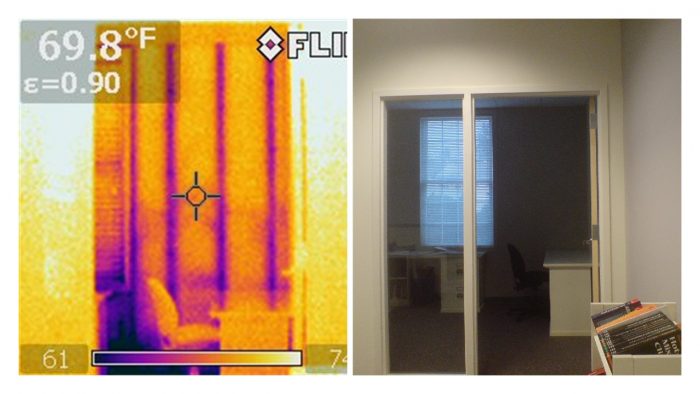
One story that’s been passed down is that a homebuilder in Las Vegas once experimented with steel framing during a time of lumber price spikes. They sold the house to a smoker, and the surfaces of the steel studs were cool enough to plate out the smoke onto the interior of the walls, resulting in a telegraphed line at every steel stud. The builder ended up buying back the house from the owner.
Infrared cameras and air
One thing to remember is that an IR camera does not see hot or cold air—the IR camera is looking through the air, and only shows the temperatures of surfaces. So, you can see temperatures of what the air is affecting, but not the air itself.
For instance, these floor-mounted heating registers throw air onto the wall very well in Figure 7. As a bonus, this demonstrates the Coandă effect, which is air (or other fluid) following an adjacent flat or curved surface, thus resulting in increased throw (check out ACCA Manual T for more).
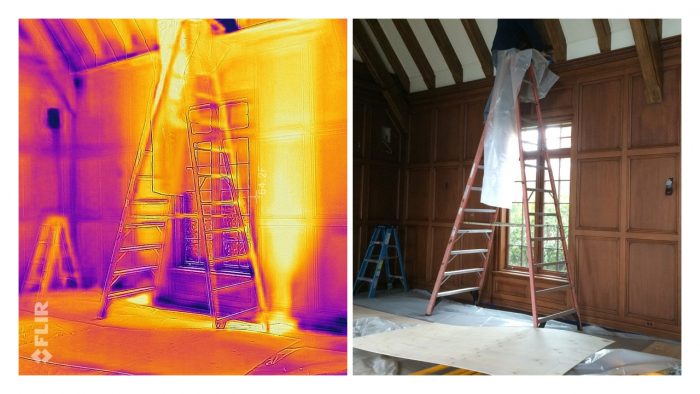
A problem-solving infrared observation was this wintertime shot inside a house in Figure 8. Why is the top of the room glowing? One clue is the ceiling-mounted registers in these first-floor rooms, which are the visible hot spots that are also blowing onto the tops of the walls.

The problem was that these registers were built for horizontal throw, not vertical, so they ended up layering the hot air into the top of the room’s air sandwich, resulting in pretty spectacular thermal stratification. There was nothing that broke up the hot air at the top of the room, so it stayed there, and left the bottom half cold.
If you have poured black and tans (Guinness on top of Bass ale in a pint glass), this heating system was basically doing the same thing, gently pouring out a layer of hot air on the top of the first floor’s air sandwich, without churning things up.
The problem at this house was even worse than discomfort. With this stratification, the thermostat was typically below the hot-cold boundary line. So the heating system ran for hours until the hot layer got deep enough to affect the thermostat. The system would shut off, then the cycle would repeat. But of course, the second floor was sweltering the entire time.
One last trick for visualizing airflows is something that I owe to Robb Aldrich at Steven Winter and Associates. If you want to visualize how an HVAC system throws air—for instance, a mini-split—put up a piece of cardboard that cuts a cross section of the air plume, and it shows up beautifully in infrared.
Air + Heat (enclosure depressurization and infrared)
A combination that many of you are probably familiar with is fan pressurization or depressurization plus an infrared camera to sleuth out building air leakage—we are combining the topics of air and heat now. This powerful technique relies on an indoor-outdoor temperature difference to visualize leakage
We have the choice of pressurizing or depressurizing the building. Pressurization (forcing air into the building, Figure 9) results in “induced exfiltration” or outward leakage of interior air; the leak would be visible on the outside of the building. However, these air leakage thermal anomalies are often overwhelmed by outdoor surface temperatures, especially during the day, when the building is sunlit.

Depressurization (pulling air out of the building, Figure 10) results in “induced infiltration” or inward leakage of exterior air; the leak would be visible on the inside of the building. This is my typical go-to technique. I recommend walking around the building with an infrared camera first to find any existing thermal anomalies (such as thermal bridges). Then, I would depressurize the house (turn on the blower door fan), and do another walk of the building, to see what has changed.
One characteristic of air leaks is they often appear as plumes or jets of air, as shown at a leaky door bottom in Figure 11. Once again, this shows up on the surfaces being hit by that cold outside air (induced infiltration).

Tongue and groove ceilings are a classic problem when they run from indoors to outdoors at the gable end or roof rake. Depressurization in wintertime shows air jetting in at every board joint (Figure 12).
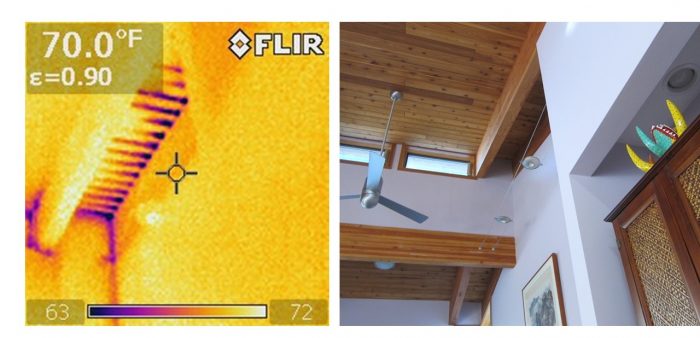
This technique can also be used to find air leakage hidden behind interior finishes. Figure 13 shows a vented cathedral ceiling during summertime depressurization: hot outside air is leaking in at the roof ridge vents, through fiberglass insulation, and is getting pulled inside via the recessed lights and other ceiling plane air leaks.
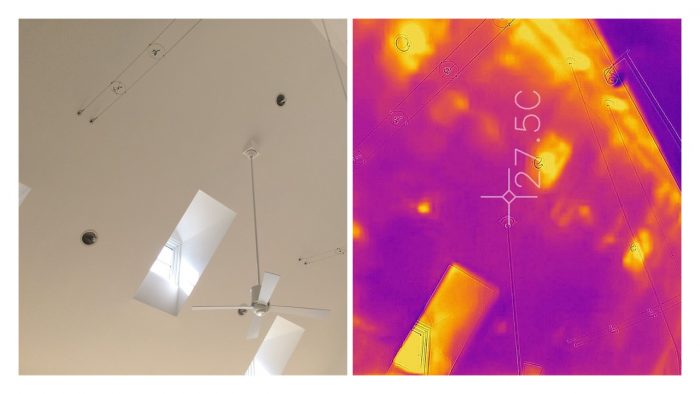
Similarly, Figure 14 shows outside air being pulled from the hot vented attic above the ceiling, down into the interior wall (“wing wall” at the bathroom) and the top plate of the outside wall.
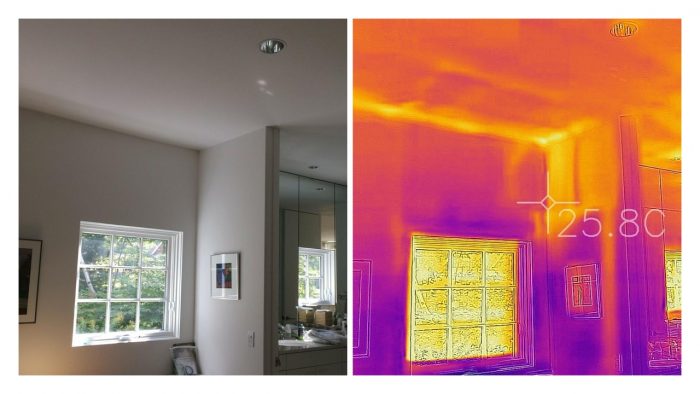
Spray foam is often used because of its air-tightening qualities. It provides an excellent air barrier where it is present and continuous. However, at discontinuities where it is not present, it does nothing to stop airflow. In other words, spray foam doesn’t air seal when it isn’t there. This commonly occurs in wood frame construction at wood-to-wood joints, such as king/jack/cripple stud joints, corners, top and bottom plates, and rafter connections.
An example of this is shown in Figure 15, which is a flash-and batt assembly (closed-cell spray foam and fiberglass batt) shown being depressurized in wintertime. A huge fan of cold outside air is getting pulled in at the roof-to-wall joint. Pulling back the fiberglass (Figure 16) revealed a row of unsealed wood-to-wood joints at the rafter-to-ceiling joist connection.
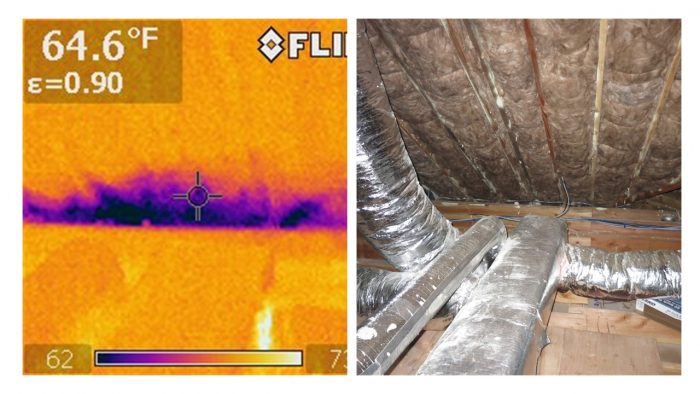
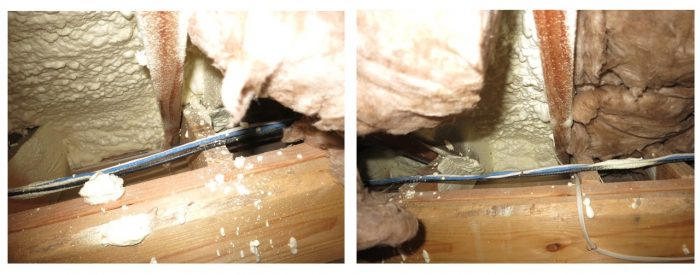
Another troublesome detail is windows that are installed using side clips (commonly called masonry straps) and/or window shims. Figure 17 shows a window that was well sealed around its perimeter, except where the shims penetrated through. The recommended detail is to cut the shims off flush, and to run the air sealing detail over the surface.
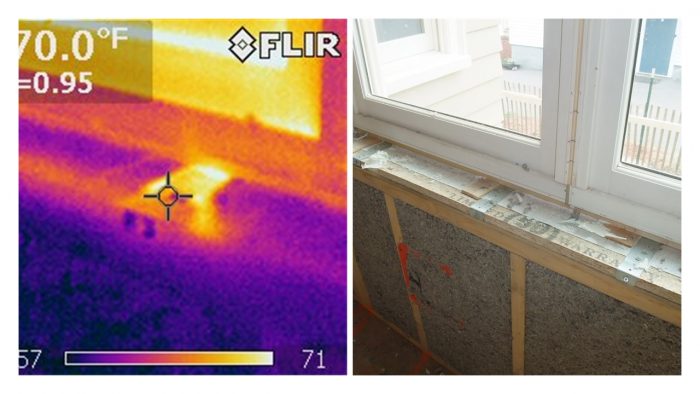
Good solutions to window side clips include using a tape seal covering the entire clip/strap (Figure 18) or embedding the entire clip in the same sealant used around the window perimeter (Figure 19).
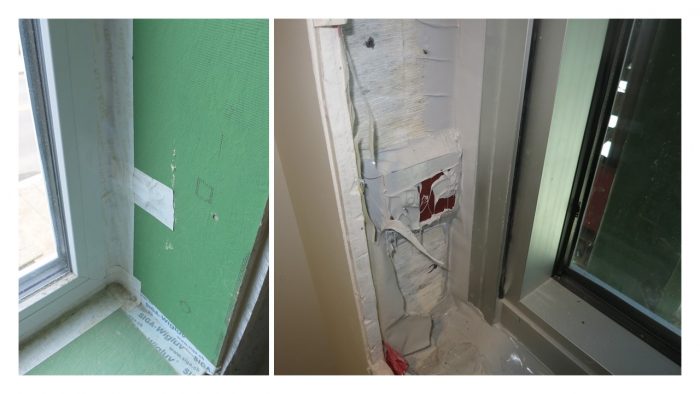
A bit about cameras
I have only been using IR cameras since 2008, so I’m definitely not an old-timer from the days of liquid-nitrogen cannisters and cart-size cameras. I started out using a FLIR b40 (Figure 20), which sold for about $5000 when it was new, came in an armored Pelican case, and put out 240 x 240 pixel images (IR resolution: 120 X 120 pixels). Taking a $5000 instrument to bang around in an attic was never a comfortable feeling. Also, the image was a narrow soda straw view. You had to step back to get a good view of the building, and at that point, the image was too blurry to be useful.
Here’s a tip: use a fixed temperature scale, snap multiple images in a panorama, and stitch them together in photo-editing software if you need to.
Nowadays, we can all benefit from advances in technology. I currently carry around a FLIR ONE Pro, which plugs into a smartphone and runs about $400 (Figure 21). It puts out 1440 x 1080 pixel images, overlaying a visual image (showing edges) with the infrared shot. That overlay is a very useful reference (“Right…this shot was in the room with that godawful velvet painting”). That painting would be the same temperature as the wall, and mostly invisible with infrared alone. It also slips into your pocket for trips up to the attic. Simply put, today I get a better image at a tenth of the price.
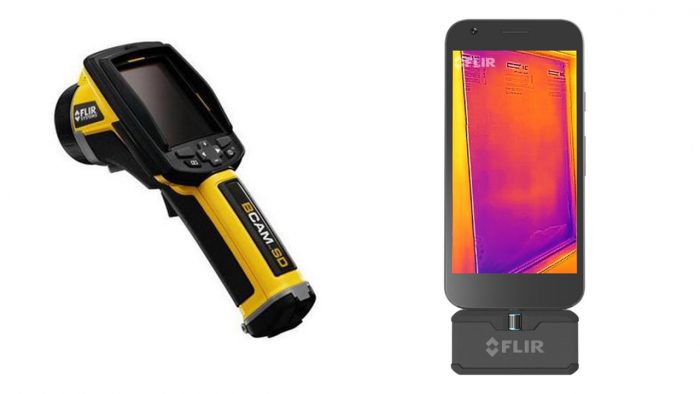
There are many brands and models available. I have not tried out the Seek IR camera, so I can’t offer any comparisons. However, I have a few warnings and lessons learned from my IR camera. I’ve gotten some pretty strange numbers from the temperature readout, so I rely on it more for the image than surface absolute temperature measurements. It seems like the phone battery drains quickly while running the software. Using this setup outdoors in winter results in really quick battery drain, so I need to tuck it into my coat between shots. Pairing infrared shots with visual shots (like I’ve done above) makes it much clearer what is going on in reports and presentations. Lastly—be careful of the connector that plugs into the phone: if you knock it around, it can fall right off (Figure 22). FLIR doesn’t repair these units, but they offer a discount on a replacement when sending back the broken unit.
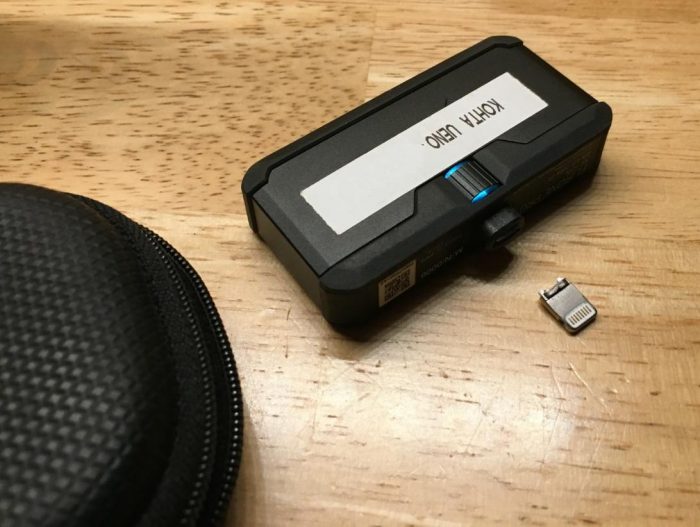
Shiny surfaces and furry things
IR cameras rely on an assumed value for emissivity—emissivity is the “E” in window “low-E” coatings. Shiny surfaces have a low emissivity and can result in weird results. Specifically, shiny surfaces reflect in infrared, the same way that mirrors do in the visual spectrum.
I ran into this while scanning hallways in a building (Figure 23). “Wow,” I thought, “there are some serious thermal anomalies at that elevator door. Is there a massive summertime air leak? Oh wait, that’s a reflection of me and a colleague, as well as the overhead lights.” Yes, I accidentally took an infrared selfie.
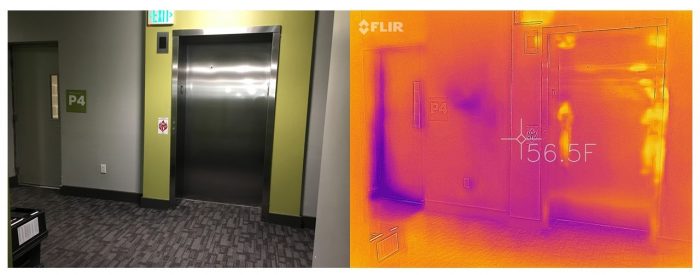
The same thing happens when you look up inside a suspended ceiling and point an infrared camera at shiny sheet metal ductwork. The tell is when that thermal anomaly starts moving around as you move around.
Lastly, you sometimes run into surprises with an infrared camera as shown in Figure 24. I was scanning a client’s basement thinking, “Cool basement walls, warm water heater, hot pipe…WHAT THE WHAT IS THAT?!” If you turn on a flashlight (or turn up the brightness in the visual shot), you’d see that the homeowner’s black cat likes to perch on the basement wall.
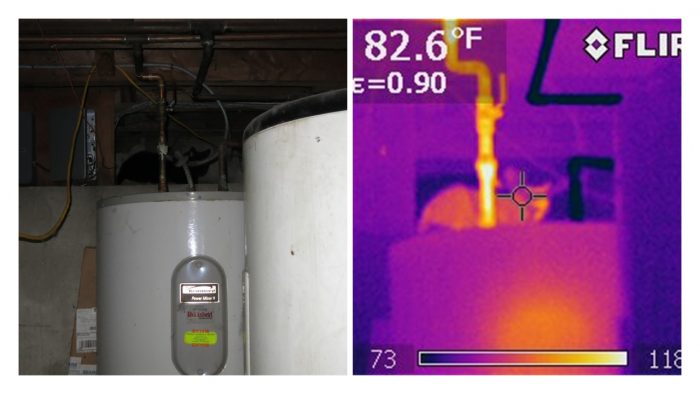
-Kohta Ueno is a senior associate at Building Science Corporation. Photos and illustrations courtesy of the author.
Weekly Newsletter
Get building science and energy efficiency advice, plus special offers, in your inbox.
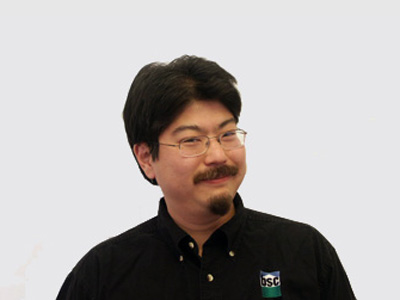




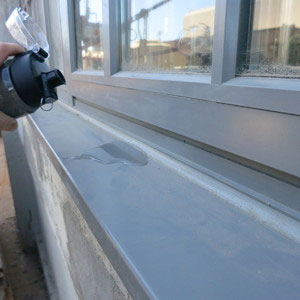

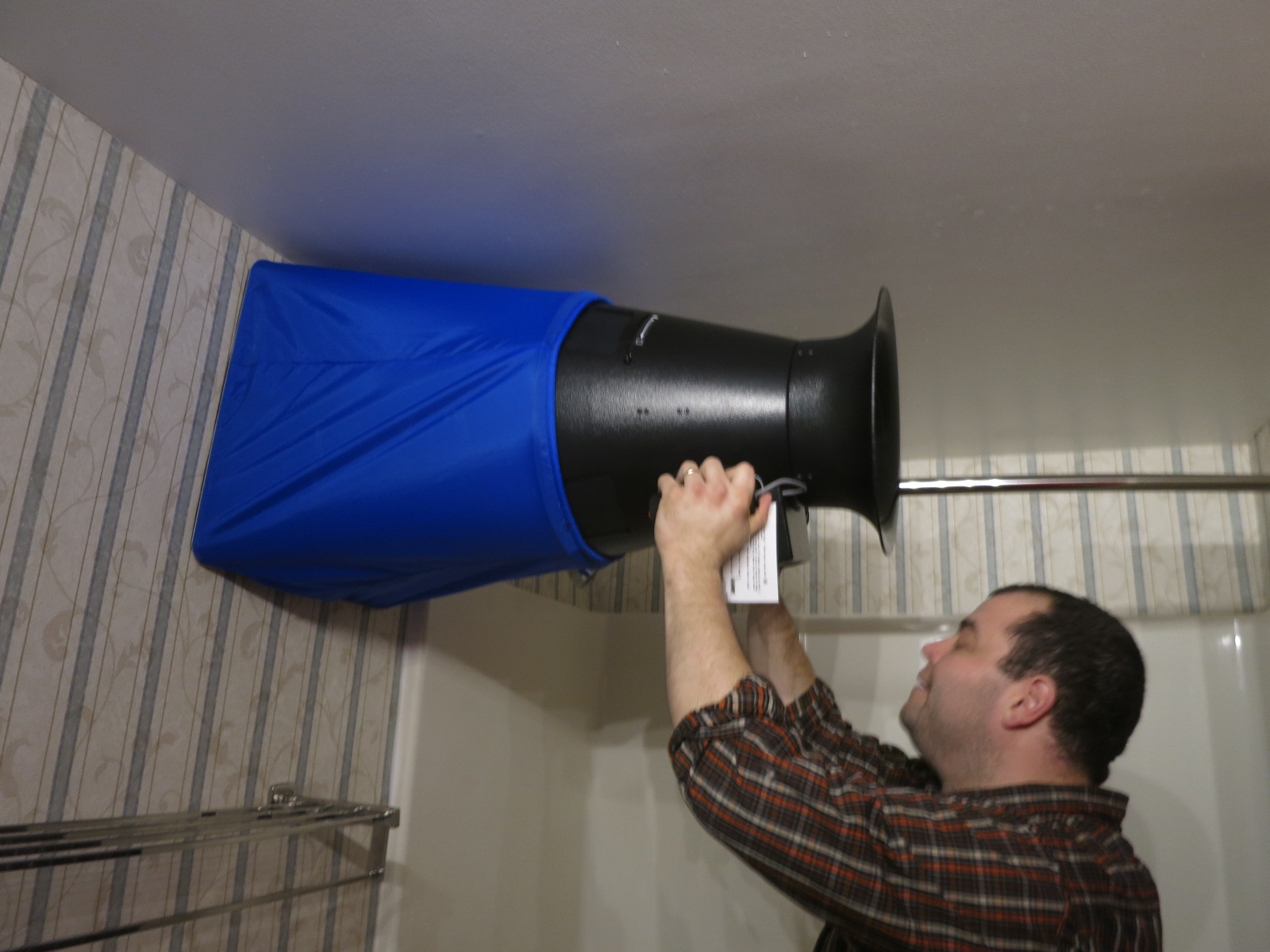







17 Comments
Hi, thanks for this, I have access to a FLIR iPhone attachment. I wonder if there is an ideal temperature differential between inside the structure and the outside temperature in order to get the best data? Does it depend what I'm looking for? From inside, for cold air drafts/spots. From outside, for thermal leaks?
Tx . Scott
I can't find the reason, but many references use 10C as a minimum temperature differential. I also had an auditor tell me they couldn't do an "official" audit with less than 10c differential.
I usually shoot for 10-20 F temperature differential, but don't expect much for results at the lower end of that range. Also, be sure to watch out for tricky situations--if you're relying on outdoors to be cold, for instance, a vented attic on a sunny day might be warm enough to reduce the effect of cold air. In addition, a "short path" air leak--like at a door threshold or window meeting rail--is easier to see thermally than a hidden air leak that needs to cool down/warm up a surface (leak hidden behind drywall), and where the air needs to take a "tortuous path."
I would imagine that there is some advantage to doing both pressurization and depressurization and looking at both the exterior and the interior. Also that if it happens to be 70F inside and outside, that you can crank up the building heat to get a usable temperature difference.
You *can* sometimes get decent results pressurizing and looking at the outside, but you have to watch out for sun-warmed surfaces and thermal mass (e.g., brick veneer staying warm after the sun has gone down). Pressurizing can be a more useful technique at night, but I don't often have access at night in my investigations.
Also, completely agree with pre-warming or pre-cooling the building to "goose" the temperature difference/delta T. That requires some coordination with folks operating the building, but is effective.
The "mystery" thermal hot spots in figure one are pretty obvious. I started out browsing the pictures before even reading the article, and instantly understood what those were without even thinking. I guess most people are only passingly aware of that giant, glowing orb in the sky and what it does.
I played around with a thermal camera last winter in and around my house, and a neighbour's house. One thing I learned is that you have to be very careful with how you calibrate it. Allowing it to auto calibrate the image can provide very misleading results. Depending on the range, it can completely hide thermal aberrations, or over emphasize them. You can almost make it show whatever you want it to show.
I notice the camera you used has the same deficiency that the one I was using (a Milwaukee) did: the resolution/field of view/zoom of the IR image is different from the visible light image. This is a huge shortfall that I would have thought wouldn't be that hard to solve.
>"I notice the camera you used has the same deficiency that the one I was using (a Milwaukee) did: the resolution/field of view/zoom of the IR image is different from the visible light image. This is a huge shortfall that I would have thought wouldn't be that hard to solve."
Not really easy to solve AT ALL with room-temperature IR imagers. The visible light imagers operate on the photoelectric effect, and the pixel sizes can be quite small, for high resolution images. With cryogenic IR imagers that operate on photoelectric effect the pixel sizes can also be pretty small, but even the smallest refrigeration systems at bulk and cost to the system, and make it less rugged/reliable for use in the field.
A couple of decades ago the industry started shifting toward micro-machined resistors on microscoopic thermally isolating silicon pickle-forks, which offers reasonable IR temperature resolution without cryogenic temperatures. But micro-machined resistors are a few orders of magnitude larger than a CCD cell or CMOS imager cell.
There are still plenty of military, scientific & engineering applications that call for higher resolution IR imagers, but all of the cheaper commercial & industrial (and now practically consumer ) type IR cameras have gone to the non-crygenic but lower-res solutions. For applications such as chasing down heat leaks in buildings & heating systems even the $200 FLIR One is a pretty good tool.
My FLIR One has proven to be extremely useful. Obviously the temperature readings are close at best because of the various emissivities of typical building surfaces, but once you wrap your head around the concept it’s awesome for checking temperature difference across a floor or wall. If you need accurate temperatures of shiny metal ductwork, a can of semi-gloss black paint comes in handy.
Regarding visible vs thermal image field of view, FLIR uses both visible light and thermal imagers to provide composite images. They call it MSX, and it makes otherwise low resolution thermal images much more useful.
Looking at the cat, I'd say that different cameras and/or positions were used. So simple scaling can't fix it.
An example showing my previously drafty (and FREEZING COLD) kitchen floor. After at sealing the rim joist the floor is much warmer:
Regardless of native resolution, having the two images align is simply a matter of scaling. And they are already scaled, they got kind of close. Just far enough off that it can be difficult to match up objects in the images if there isn't a distinct landmark visible in both.
And the same area after air sealing:
Nice!
"The problem was that these registers were built for horizontal throw, not vertical, so they ended up layering the hot air into the top of the room’s air sandwich, resulting in pretty spectacular thermal stratification."
What's the best register design for ceiling heat, assuming registers are already installed in ceiling, facing down, and would a vertical ceiling heat design be compatible with summer cooling?
"IR cameras rely on an assumed value for emissivity—emissivity is the “E” in window “low-E” coatings. Shiny surfaces have a low emissivity and can result in weird results. Specifically, shiny surfaces reflect in infrared, the same way that mirrors do in the visual spectrum." If this is the case how do you manage shiny insulated ducts and/or FSK insulation, if you're looking for temperature differences and opportunities for more insulation?
thanks!
I can answer the second question.
IR cameras usually have adjustable emissivity settings which you could hypothetically use to adjust for shiny stuff.
However the shorter answer is, they're not very useful on shiny stuff in the real world. FSK and foil insulation have varying amounts of dust on them and/or are prone to reflecting other heat sources (most likely the camera operator, but I've also seen recessed lights, warm pipes, pets, etc.), so the practical obstacles are large.
You can still look around insulation for hot or cold spots formed by air leaking through.
What's the best register design for ceiling heat, assuming registers are already installed in ceiling, facing down, and would a vertical ceiling heat design be compatible with summer cooling?
If it clarifies things, I have attached a few images from ACCA Manual T to explain the problem. "ACCA Manual T Horizontal Ceiling Discharge.png" shows the condition in that IR shot--horizontal throw ceiling registers operating in heating, "layering" hot air at the top of the room, resulting in really bad stratification.
"ACCA Manual T Vertical Ceiling Discharge.png" shows what I recommended--you want a ceiling register that "shoots" the air downward, breaking up this stratification pattern. I.e. a "vertical throw" instead of "horizontal throw" register.
"ACCA Manual T Vertical Ceiling Discharge Cooling.png" shows that vertical throw register operating in cooling mode--pretty much works; there's a bit of a stagnant zone near the ceiling, but it doesn't matter too much.
In general, in air distribution systems, you want to deliver heating from the floor, and cooling from the ceiling... so any air distribution system that does both will always be a bit of a compromise.
If this is the case how do you manage shiny insulated ducts and/or FSK insulation, if you're looking for temperature differences and opportunities for more insulation?
If you really want to know the surface temperatures, one option is to put something non-shiny on the shiny surface to get an idea of its temperature, without reflections. For instance, if you have a roll of masking tape, you can put that on the surface.
Also, a layer of dust will mostly negate the effect of a low E surface--it is no longer "shiny" in that case, so it no longer provides low emissivity. I showed some infrared shots of this condition when I was showing how useless bubble wrap duct insulation is here (Comment #7).
Is Bubble Wrap Duct Insulation a Good Idea?
Although reflective layers can be effective when installed correctly, they aren't the best way to insulate ducts
https://www.greenbuildingadvisor.com/article/is-bubble-wrap-duct-insulation-a-good-idea
What a useful and interesting article! I bought a Flir One Gen 3 as a xmas gift to myself but was back ordered and got it last Friday, Went to my in construction cottage this weekend and practically had a heart attack when looking at the ceiling and saw the cellulose insulation above showing blue sections... there is 20" of cellulose so I was quite unpleased with what I was seeing... took me until the morning after to realize that was I was seeing is the reflexion of the doors/windows on the alu-faced polyiiso :-) (see pictures)
But I was also able to find a few cold spots around my windows that did not get enough insulation and was able to correct it before I start drywalling in the next few weeks, Very useful tool!
Log in or create an account to post a comment.
Sign up Log in